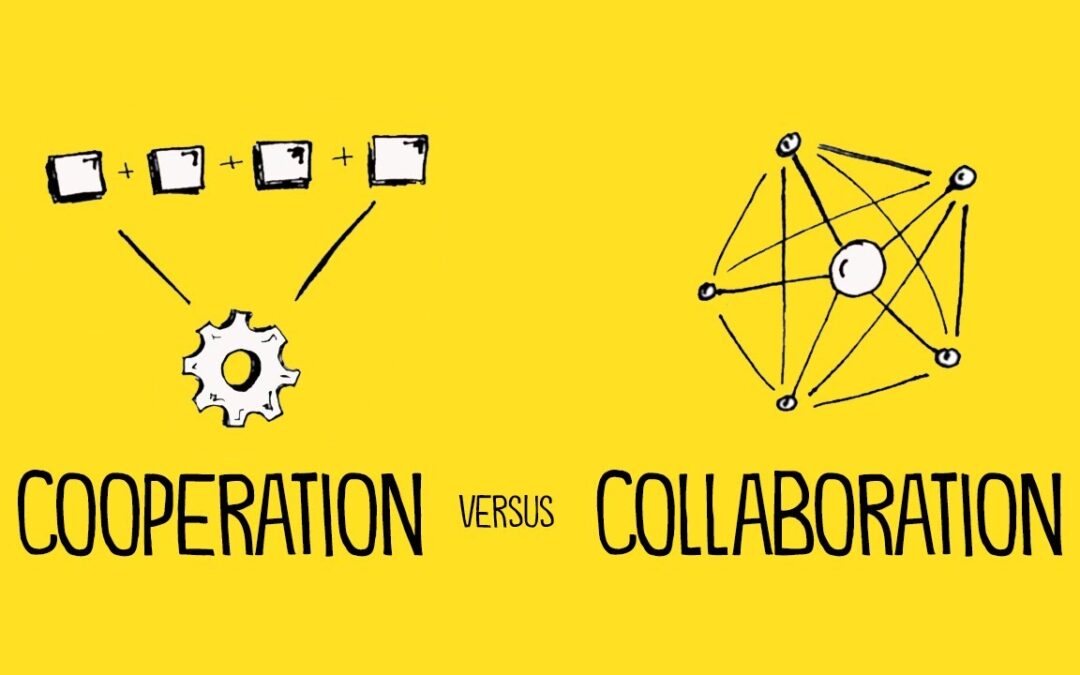In our race to enable and support hybrid teams, our reliance on collaboration software has inadvertently caused us to forget the art of true collaboration.
The pandemic forced us to rely on digital platforms for communication and creativity. But as we embraced these tools, something essential was lost in translation. Last week, I watched team members sitting elbow-to-elbow spend two hours synthesizing discovery interviews and debating opportunity areas entirely by chat.
What collaboration is
“Collaboration” seems to have joined the ranks of meaningless corporate buzzwords. In an analysis of 1001 values from 172 businesses, “collaboration” was the #2 most common value (integrity was #1), appearing in 23% of the companies’ value statements.
What it means in those companies’ statements is anyone’s guess (we’ve all been in situations where stated values and lived values are two different things). But according to the dictionary, collaboration is “the situation of two or more people working together to create or achieve the same thing.”
That’s a short definition with a lot of depth.
- “The same thing” means that the people working together are working towards a shared goal in which they have a stake in the outcome (not just the completion).
- “Working together” points towards interdependence, that everyone brings something unique to the work and that shared goal cannot be achieved without each person’s unique contribution.
- “Two or more people” needing each other to achieve a shared outcome requires a shared sense of respect, deep trust, and vulnerability.
It’s easy to forget what “collaboration” means. But we seem to have forgotten how to do it.
What collaboration is not
As people grow more comfortable “collaborating” online, it seems that fewer people are actually collaborating.
Instead, they’re:
- Transacting: There is nothing wrong with email, texts, or messaging someone on your platform of choice. But for the love of goodness, don’t tell me our exchange was a collaboration. If it were, every trip to the ATM would be a team-building exercise.
- Offering choices: When you go out to eat at a fast-food restaurant, do you collaborate with the employee to design your meal? No. You order off a menu. Offering a choice between two or three options (without the opportunity to edit or customize the options), isn’t collaboration. It’s taking an order.
- Complying: Compliance is “the act of obeying a law or rule, especially one that controls a particular industry or type of work.” Following rules isn’t collaboration, it’s following a recipe
- Cooperating: Cooperation is when two or more people work together independently or interdependently to achieve someone else’s goal. Collaboration requires shared objectives and ownership, not just shared tasks and timelines.
There’s nothing wrong with any of these activities. Just don’t confuse them with collaboration because it sends the wrong message to your people.
Why this matters
This isn’t an ivory-tower debate about semantics.
When people believe that simple Q&A, giving limited and unalterable options, following rules, and delivering requests are collaboration, they stop thinking. Curiosity, creativity, and problem-solving give way to efficiency and box-checking. Organizations stop exploring, developing, and innovating and start doing the same thing better, faster, and cheaper.
So, if you truly want your organization to grow because it’s filled with creative and empathetic problem-solvers, invest in reclaiming the true spirit of collaboration. After all, the next big idea isn’t hiding in a chat log—it’s waiting to be born in the spark of genuine collaboration.

This article is so on point! There are so many “collaboration” tools that folks like to use these days in lieu of actually having conversations. Thank you for bringing this to light Robyn!
Thank YOU for corroborating what I’m seeing (though sad that you’re seeing the same thing). You work so closely and deeply with organizations that if you’re seeing it, it must be more widespread and multi-generational than I thought.
We’ve somehow forgotten that collaboration builds and strengthens relationships, the most essential and most basic need in any organizations success. And we wonder why the results aren’t there and the health implications continue to rise. Hmmm
Such a great point, Gretchen! Relationships are the key to everything – happiness, success, longevity, and so on. Genuine relationships require conversation, connection, understanding, empathy, and time. You can’t clickety-clack (type) your way to meaningful relationships. Thanks for making this incredibly important point.